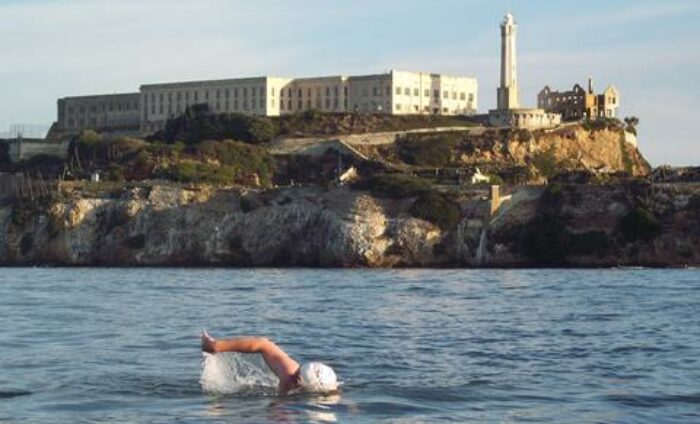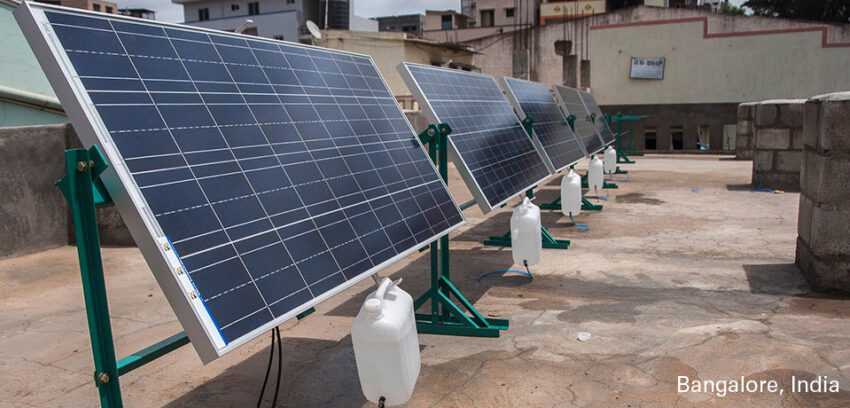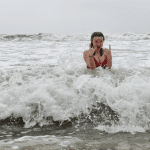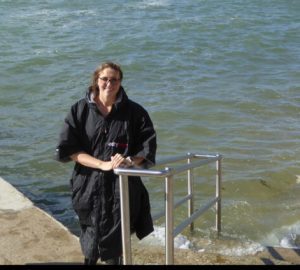
Six open water swimming tips from Alcatraz veteran, Gary Emich
Image: Peg Gerard
Open water legend and fanatic Gary Emich is most widely known for his world record setting, 1,000 swims of the Alcatraz crossing. Other than breaking world records in San Francisco Bay, Gary also has swum with piranhas in the Amazon, looked Nessy in the eye in Scotland’s Loch Ness, and escaped from the Italian mafia into the Bay of Naples. Okay, so he’s probably kidding about the Nessy and Italian mafia part, but he did really swim with piranhas and in Italy and Scotland. Gary has previously written for H2Open Magazine as well as Triathlete, Inside Triathlon, and Triathlon Life USA. With now more than 1,000 Alcatraz swims done (that’s right, he didn’t stop at 1,000) and with decades of open water experience, Gary shares his six top tips on improving your open water swimming.
1) Enter the Aquatic Wind Tunnel
All of us have tooled down the highway at some time in life with one hand out the window, feeling the force of the wind. Keep your hand flat and horizontal, pointed down the road, and the wind rushes right by. Lose that aerodynamic position and your hand is flung perpendicular by the power of the wind’s pressure.
The same principle applies to swimming. Water is over 800 times denser than air so there’s a lot to be said for minimizing your frontal surface area while swimming through water. Few swimmers devote enough time refining their stroke to reduce drag. Instead, most swim harder in the hopes of muscling their way to faster times. Focus on maintaining a body position that minimizes how much water you have to swim through. I always tell people to visualize swimming through the smallest tunnel possible so you’re getting through the water easier. Just as downhill skiers maintain a good tuck position and just as we have aerobars on our bikes to reduce wind drag, envision yourself swimming through an Aquatic Wind Tunnel with your body as streamlined as possible.
2) Tap into Hip Power
Ever watch a golfer or baseball batter? Where does the power come from? Not from the arms but from the hips. The same is true in swimming. Your real power comes from your hips. In Australia, the Aborigines have spear slings called Atlatls that allow them to hurl the spears a further distance. Closer to home, many dog owners use dog ball throwers so they can throw Fido’s ball further with greater ease. As it relates to swimming, visualize your hips (Atlatls/dog ball thrower) initiating the extension of your forward arm (spear / ball) into the water. When your forward arm extends, it’s the snap of your same-side hip that should launch the extension. This helps get you on your side where there is less body surface exposed to the oncoming water. Think about it – a sail boat slices through the water quickly while a barge has to muscle its way through the water. Use your hips to launch your forward arm extension and get you on your side.
3) Perfect your Hand and Arm Entry
Assess your hand entry. Your hand should enter the water slightly in front of your head. Then your wrist, forearm, elbow and upper arm should all go through the same hole made by your hand. This necessitates that you maintain a high elbow during your arm recovery. If you find yourself slapping the water with both your hand and your elbow at the same time, chances are you’re not letting the downward snap of your hip drive your arm extension and/or you do not have a high elbow. You can make a game out of this by seeing how quietly and how few bubbles you make during your hand and arm entry – the less noise and fewer bubbles the more efficient your stroke.
Equally important: maintain a 10 o’clock (left hand) and 2 o’clock (right hand) entry into the water (shoulder width apart). Think of that grocery cart at the super market – push it with your right hand and it will veer left and vice versa with your left hand. The same thing happens when your hand crosses your centre line – your body will zig-zag through the water like a sea snake.
4) Anchor your hand before you pull through
Once your hand enters the water, reach and extend underwater so you can glide and get another inch or two out of your stroke. This also allows you to anchor your hand securely in the water before pulling back. Pay attention to the water gliding over your finger tips and don’t begin your pull back until you feel the flow of water over your fingertips diminishing. Make sure you maximize your pull leverage by using both your hand and your forearm. The best way to learn a proper pull position is to practise fist drills. Close your hands into fists and swim several laps – it won’t take long to learn where the best position is to grab more water. One-arm swimming drills do the same thing. Put your left arm out in front of you and then just swim with your right arm (then vise versa) – you quickly learn the best pullback arm position. Did you ever wonder why so many wetsuits have a different material on the forearm? It’s designed to help you grab more water – learn to use your forearm.
5) Sight with alligator eyes
In the open water there are no black lines or lane ropes. Good sighting skills can shave considerable time off your swim without any extra effort or aerobic output on your part. By learning to swim a straight line from start to finish, you avoid zigzagging and adding unnecessary distance and time to your swim. In the instance of open water swimming, it’s not always the fastest athlete who exits the water first but rather the one who can follow the best line.
So how do you know if you swim straight? At your next pool workout, close your eyes and without pushing off the wall swim until you bump into the lane line. Repeat the drill until you begin to notice a pattern. How many strokes do you take before you hit the lane rope? If you hit the lane line every fifth or sixth stroke, then sight every fifth or sixth stroke. Some swimmers can stroke 15 to 20 times before sighting while others need to sight more frequently. If the water is exceptionally rough, you may need to sight even more frequently.
Practise sighting during your cool-down. Pick an object on the other end of the pool: a life guard ring, an exit sign, a light, etc. and then lift your head slightly every few strokes to spot it. The most important aspect is to practise “alligator eyes”. Don’t lift your head up so much you throw your body off its horizontal axis and out of the Aquatic Wind Tunnel. Just look up enough so only your eyes are above the water – like an alligator.
6) Learn to breathe both sides
When swimming from Alcatraz back to shore the winds frequently whip in from the west with waves crashing into me on my right. If I could only breathe to my right, I would be breathing water the entire swim. Therefore, bilateral breathing is a huge skill to have in your arsenal. If you can breathe with ease to either side, the benefit is obvious. Unfortunately, there is no magic bullet for learning to breathe bilaterally. It takes over 15,000 repetitions to reprogram your body so a new movement feels natural. Practice, practice, practice.
Invest the time; the pay-back is three-fold. Your neck muscles are more balanced. You improve your sighting since you now look in two directions. And, most importantly, during rough water conditions, when the waves hit your face from one direction, simply breathe on the other.
Get personalised training advice from Gary
Open water swimming is complex and everyone’s challenges and ambitions are unique. Sometimes, some personalised advice can make all the difference, whether it’s discussing the type and amount of training you need to do or planning what swim to take on next. Gary’s expertise is, of course, on Alcatraz, but his knowledge is much wider than that. Gary is currently working with the website givegetwin.com to give 10 people the opportunity for a phone consultation during which you can ask your most pressing questions about open water swimming and Gary will offer his expert advice. The consultations cost $45 and the entire fee will be donated to SunSaluter, a not for profit organisation working in the developing world (Gary does not receive a cent).

SunSaluter is dedicated to improving energy and water access through the SunSaluter technology, a solar panel rotator designed for the developing world. Using only the power of gravity and water, the SunSaluter enables a solar panel to follow the sun throughout the day, boosting efficiency by 30% and producing four litres of clean drinking water. The company believes that a market-based approach is necessary to bring the SunSaluter to those who need it most, so it helps local entrepreneurs establish for-profit businesses around their technology.
If you have any further questions about the deal, charity, and any other information, please contact Gabi at gabriela@givegetwin.com.






